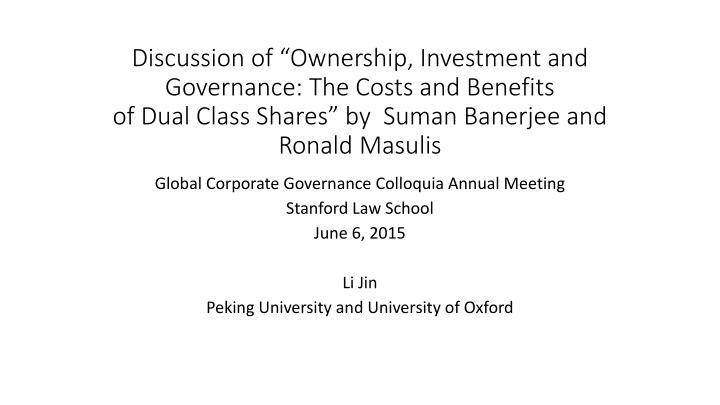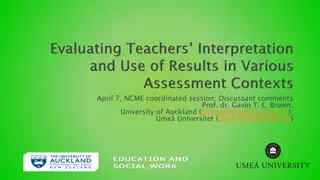
Benefits and Costs of Dual-Class Shares in Corporate Governance
Explore the benefits and challenges of dual-class shares in corporate governance, focusing on mitigating underinvestment issues while potentially weakening control incentives. Practical implications and trade-offs are discussed, suggesting a nuanced approach in allowing dual-class structures.
Download Presentation

Please find below an Image/Link to download the presentation.
The content on the website is provided AS IS for your information and personal use only. It may not be sold, licensed, or shared on other websites without obtaining consent from the author. If you encounter any issues during the download, it is possible that the publisher has removed the file from their server.
You are allowed to download the files provided on this website for personal or commercial use, subject to the condition that they are used lawfully. All files are the property of their respective owners.
The content on the website is provided AS IS for your information and personal use only. It may not be sold, licensed, or shared on other websites without obtaining consent from the author.
E N D
Presentation Transcript
Discussion of Ownership, Investment and Governance: The Costs and Benefits of Dual Class Shares by Suman Banerjee and Ronald Masulis Global Corporate Governance Colloquia Annual Meeting Stanford Law School June 6, 2015 Li Jin Peking University and University of Oxford
Summary This paper argues for a more balanced view of the role of dual-class shares. Although a dual-class structure weakens the incentives associated with the market for corporate control, at the same time it helps to mitigate the underinvestment problem resulting from the non- contractibility of a firm's investment policy. When a firm issues voting shares to raise funds, it increases the risk that manager-controlling shareholder could lose control of the firm and lose the associated private benefits. Thus, the incumbent may be willing to forgo positive NPV investments to maximize his overall welfare.
Summary Concretely, they look at the scale expanding projects, which requires more financing. They also assume that debt is not an option (due to bankruptcy risk), and that insider is wealth constrained and thus cannot buy more (voting) equity. Then, absent the use of non-voting shares, insider faces the dilemma of issuing voting shares and thus diluting his voting power (and thus risk losing control), or not fully investing in the project. Intuition is shown using an elegant numerical example and a full blown model.
Summary Model fits the empirical observations well. The model predicts that high growth firms, rather than firms with lots of assets-in-place, are more likely to use dual-class shares and this prediction is consistent with existing empirical findings in Lehn et al. (1990) and Dimitrov and Jain (2006). It also offers new testable predictions for empirical works.
Comments I think this paper is really about the bright side of dual class shares. While acknowledging all the problems associated with dual class shares as pointed out by the previous literature, this paper highlights the benefits of dual class shares: it mitigates a potential underinvestment problem. Takeaway: The real world situation is complicated, and the existence of dual class shares in many places around the world can be justified through an optimal tradeoff of benefits and costs. The equilibrium might allow SOME dual class shares. I think there would be little objection to these statements
Comments First of all, I think it might simplify the thought experiment if we go back to IPO, the very beginning of the issuing of the various debt and equity instruments by the insiders, to see whether dual listed shares are justified. Slightly different from the current setup (SEO), whereby a firm already has outside (voting) equity holders, and the insider is deliberating on whether to ADD a new class of non-voting shares in the SEO. Two considerations: Many (most?) of the dual class shares that I know were created at the IPO, not SEO. For the reason mentioned in the paper, it is the early stage of a firm s life cycle that we are more likely to encounter unpredictable investment opportunity set (thus the bigger benefits of dual class shares). Thus if a firm finds it optimal to add a dual class share at the SEO, it would likely find it also optimal to do so at the IPO.
Comments Analyzing the IPO capital structure choice also allows us to link more closely to the typical workhorse in the literature: We have a wealth-constrained insider/entrepreneur, faced with a positive NPV project today (and a string of future projects with unpredictable NPVs), trying to solve for an optimum, using various capital structure instruments: equity (both voting and non-voting), debt, others. In a competitive market, if outsiders are assumed to be breaking even, then all the surplus accrue to insider, so what is socially optimal for the total benefits (both public and private) should also be privately optimal for the insider. The question is, does the equilibrium allow for non-voting shares? The answer of the paper: Yes.
Comments If we allow for dual class shares, should we also allow other solutions? Preferred debt (less concerns about bankruptcy)? Other hybrid securities? Derivatives? Solving the insider s wealth constraint directly by allowing him/her to borrow from the firm so as to maintain a constant percentage ownership in the face of new outside equity issuing, for example? If we can achieve the optimum with other, less costly, instruments, would we still need to use dual class shares?
Comments If under-investment due to concern about loss of control right is what needs to be addressed (by the dual class share), can we have other contractual ways to address that directly, without resorting to dual class shares? In PE and Hedge Fund industry, insiders get a piece of the upside (in addition to his/her share of the total invested capital). The 20-80 rule. Could potentially solve the under-investment problem by tilting insider s incentives. Would that be a more efficient solution (with the benefits, but less of the costs of a dual class share)?
Comments Voting right comes with a price tag (or, stripping the voting rights necessitate a price discount, if the outsiders are rational). In the end, are we seeing an equilibrium where insiders are paying a price (by offering to outsiders the lower priced shares, with the same CF rights but no voting right), for the private benefits that he/she gets? If that, how do we factor that into the optimization problem? Concerns about insider expropriation of outsiders: when the controls solidly rests with insiders, how does that affect the valuation of the shares to outsiders, and thus how does the design affect the overall valuation of the whole enterprise (in a general equilibrium sense)?
Comments It would be useful to see whether the predictions of the theory model can justify the observed dual class share examples of the large publicly listed firms in the US. For example, Berkshire Hathaway, Blackstone Group, Clearwire, Dolby, Echostar, Facebook, Ford, Fox News, Google, MasterCard, News Corp, Rosetta Stone, VISA, VMWare, and WebMD. Are those necessarily explainable by your theory? In many of these firms, managers/insiders don't have that many shares. Not sure how much of a lose of control we are talking about here. Warren Buffet might arguably fear less about the loss of control, as it might be unthinkable for outsiders to oust him. So, why would BH still have a dual class share?
Comments As firms mature, their future growth opportunities might diminish, and concerns over managerial conflicts of interest might increase. Your model might predict that we will see dual class shares being phased out as these cost benefit tradeoffs change. Another testable implication. Do we see that in reality? Perhaps what ISS (Institutional Shareholder Services) is advocating could be sensible: ISS wants corporate laws to be changed to require sunset provisions for companies with dual class structure, such that all shares will revert to common shares after a pre-specified time, unless a majority of inferior-class shareholders vote to reaffirm the dual-class structure."
Conclusion Overall a very interesting paper, full of good intuitions. Pointed out something that has been largely neglected by the literature. Offered a systematic approach to think about the capital structure choices, in deciding the costs/benefits of dual class shares. Predictions are very sensible. Urge the authors to test the robustness of their predictions under more complete markets.






















